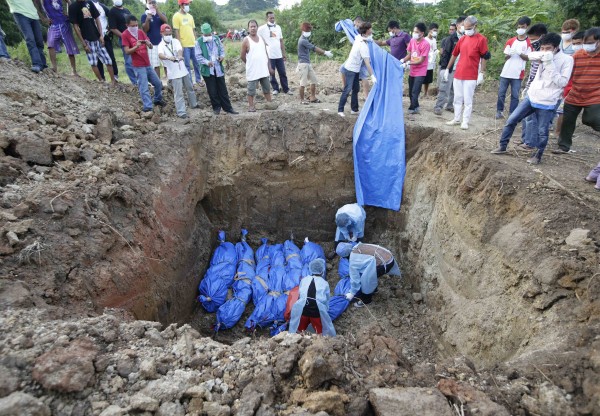Bodies of slain MNLF fighters rot in Zamboanga City battlefield

Volunteers bury the bodies of Muslim rebels killed in the 12-day standoff in a common grave at the outskirts of Zamboanga city in southern Philippines Friday Sept. 20, 2013. AP
ZAMBOANGA CITY, Philippines — Death, literally, is in the air in Barangay (village) Santa Catalina, Santa Barbara and Rio Hondo here.
Bodies of slain Moro National Liberation Front (MNLF) forces have started to rot in the battlefield, according to Army troops fighting the MNLF.
Colonel Ignacio Obligacion, commander of Task Force Igsoon, said he has been requesting the Crisis Management Committee, through the village officials, to send something to cover the smell.
“Yung amoy ilang araw na yan pero ang ikinakabahala ko ay ang possible spread ng disease (The stench has been there for several days but I’m worried about the possible spread of disease),” Oligacion said.
One officer, who asked not to be named, said they had to end the fighting as soon as possible because the stench has become unbearable.
In Santa Catalina, a group of policemen huddling and taking cover in a wall said they saw dead bodies in the interior part of the village. But recovering the bodies, they said, would be too risky because of rebel snipers in the area.
Almost all houses and structures are razed while debris and trash are scattered in the streets. The structures that withstood the gunbattle are riddled with bullets.
The streets are deserted, except for the presence of government troops and military trucks.
But fighting continued on Thursday, the 18th day of the standoff.
At dawn, successive loud explosions, believed to be delivered by artillery rounds from the Philippine Navy on Talon-talon, were heard.
The military said a total of 40 MNLF forces surrendered Wednesday night and Thursday dawn.
On Wednesday, two MNLF commanders and their 32 followers also surrendered.
“Nagtataka ako kung bakit marami yung sumusuko. Ibig sabihin marami sila sa loob since the start of this attack (I wonder why so many are surrendering. This means that many joined the MNLF since the start of this attack),” Obligacion said.
Six hostages, mostly students, were also rescued.
But Obligacion said four soldiers were killed in the fighting Wednesday night and Thursday dawn.
Captain Arvin Lawrence Llenaresas, commander of the 7th Scout Ranger Company, confirmed to the Philippine Daily Inquirer the surrender.
“May mga sumurender sa amin na may mga dalang armas (There were those who surrendered with arms),” he said. “We are happy because we see the end soon,” he added.
The MNLF members were brought to the Zamboanga City Police Station for registration and interrogation.
Early Thursday morning, two fires broke in Barangay Rio Hondo and Sumatra Island, which is part of the village of Talon-Talon.
The Philippine Navy also recovered a wooden hull that could accommodate 40 to 50 people and a motorlaunch that can carry about a hundred people.
Lieutenant Colonel Ramon Zagala, spokesperson of the Armed Forces of the Philippines, said a total of 162 MNLF forces have been captured and 138 killed.
Zagala said they have accounted for four MNLF commanders. Of the four, two Usong Ugong and Salip Idjal, are alive. Two others — a certain Kumander Haider of Sibugay and Ustadz Ismael Dasta of Basilan — were killed during the fighting.
Chief Inspector Ariel Huesca, spokesperson of the Western Mindanao Command, said Haider was known as one of the chief commanders of Misuari.
Huesca also corrected reports that Ener Misuari, who surrendered on Wednesday, was “just a follower, and not a commander.
But the government also suffered losses.
Zagala said 19 soldiers and five policemen were killed and a total of 180 were wounded in the fighting.
Of those killed, four were officers—Inspector Jay Oyoyan, 1st Lieutenant John Kristopher Rama, 1st Lieutenant Francis Damian and 2nd Lieutenant Florencio Mikael Meneses.
“We are dealing with a different terrain here. It’s called military operation urban terrain,” Zagala said.
“That is the reason why we incur a lot of injuries,” he added.














